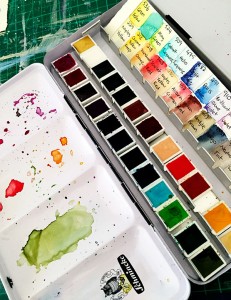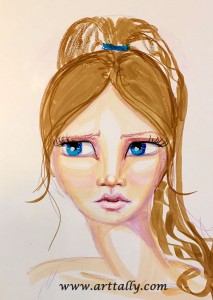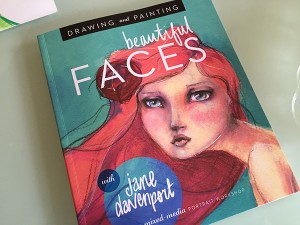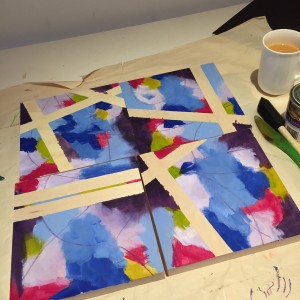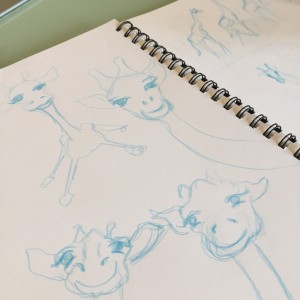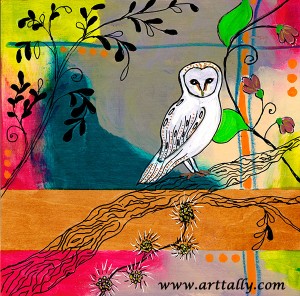3 quick tips to improve the vase life of those willful irises
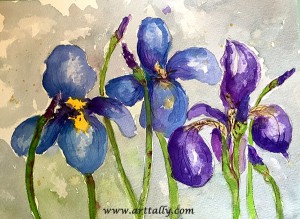 I love blue flowers. There really don't seem to be all that many of them. Irises are some of my favourites. I love how wild they seem. They don't last well in vases which is a shame, but somehow I can't help but admire that sort of willful obstinacy in refusing to be tamed.
I love blue flowers. There really don't seem to be all that many of them. Irises are some of my favourites. I love how wild they seem. They don't last well in vases which is a shame, but somehow I can't help but admire that sort of willful obstinacy in refusing to be tamed.
If you do want to try and improve the vase life of your irises here are three quick tips:
- use sharp pruning shears to cut the irises as a 45 degree angle
- add a floral preservative to the water (you can make your own with lemon-lime soda!)
- keep the vase out of direct sunlight
A new series for the first day of spring
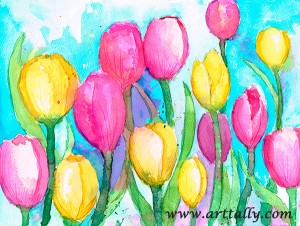 It is the first day of spring today. For the first time in what feels like a very long time we have sunshine and blue skies. My first painting in the new series for this month feels rather apt, given all that. Joyous tulips in happy colours.
It is the first day of spring today. For the first time in what feels like a very long time we have sunshine and blue skies. My first painting in the new series for this month feels rather apt, given all that. Joyous tulips in happy colours.
I am taking a class called Watercolour Secrets with the lovely Miriam Schulman, over at The Inspiration Place. These tulips are one of the class projects. They were so much fun to do, I decided to spend the whole month making more. So this month it will be a series of flowers (no faces, this time!), mostly 9" x 12" on 300gsm watercolour paper. I am using my delightful new Schminke watercolour paints... and hoping the weather holds!
How to manage your inner critic
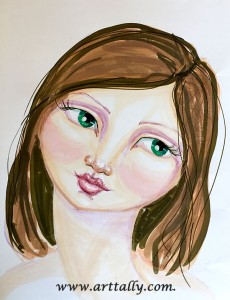 I was supposed to post Face no 12... this one above, yesterday. I drew her. I was not pleased. I decided to begin again. Having completed Face no 13, I concluded she was worse than Face no 12. Ah, the inner critic.
I was supposed to post Face no 12... this one above, yesterday. I drew her. I was not pleased. I decided to begin again. Having completed Face no 13, I concluded she was worse than Face no 12. Ah, the inner critic.
When the inner critic pipes up with her judgement, it is easy to feel paralysed. To just stop seems an easier, and far more sensible solution than to continue.
 The inner critic is a defense mechanism. Her aim is to reduce our risk. To prevent us from being judged by others, and possibly hurt in the process. However, despite these good intentions, sometimes she succeeds only in strangling the muse, and any motivation to act on any creative urge.
The inner critic is a defense mechanism. Her aim is to reduce our risk. To prevent us from being judged by others, and possibly hurt in the process. However, despite these good intentions, sometimes she succeeds only in strangling the muse, and any motivation to act on any creative urge.
Learning how to manage your inner critic stems from that awareness. Knowing that it is a protective mechanism we can acknowledge and appreciate the self care intention. From this much gentler place we can assess more rationally the seriousness of the risk perceived by the inner critic.
To make that evaluation you need to return to your 'why'. Why are you creating? There are a host of valid reasons. In fact, I don't think I can think of an invalid one. But the mere fact that you began the creation process suggests that it is a necessary self expression. We all have the right to express ourselves, regardless of our talent or ability. To create just for the sake of creating. As the creator, your job is to create, not to judge the creation.
Create because you feel the inclination to create.
Create because it gives you joy.
Create for the delight of the process.
Let the output of your creative process be whatever it will be. Inevitably, with practice you can only become better. But if you let the inner critic thwart your process in the early stages, you will never get to see that for yourself.
Is a pretty face like a passport?
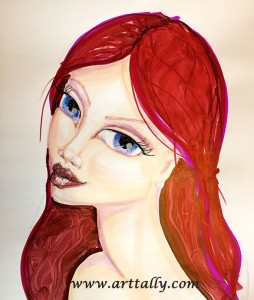 Drawing pretty faces is delightful. Especially watching perfect creamy complexions reveal themselves in the wake of the marker.
Drawing pretty faces is delightful. Especially watching perfect creamy complexions reveal themselves in the wake of the marker.
I can't help but ponder just how helpful a pretty face actually is. Some say pretty face, easy life. Perhaps so. Interesting how many judgments we make based on just a person's face. Most are positive, I'd say, but certainly not all of them.
On balance, if given a choice we would rather be pretty though, surely? It's like the old adage about money not buying happiness, but making unhappiness bearable. Being pretty opens a few doors, but has an obvious downside as Julie Burchill points out...
"It has been said that a pretty face is a passport. But it's not, it's a visa, and it runs out fast." Julie Burchill
Drawing is so good for you
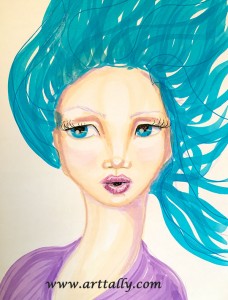 There is something delightful about drawing windswept hair and pouty mouths.
There is something delightful about drawing windswept hair and pouty mouths.
My tenth face in the series for this month includes both. And it's in my favourite combination of turquoise and purple. Life is good.
One of the beauties of taking out a drawing book is that you can make whatever it is that you want to see. Create a world composed entirely of the things you like. Omit everything you would rather not see. Such freedom. Where else can you find that?
Small wonder that drawing is so good for you.
Do we only see what we expect to see?
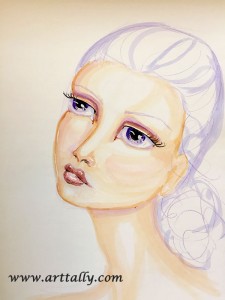 Face no 8 in the faces series turned out to be a thoughtful little thing with pensive purple eyes.
Face no 8 in the faces series turned out to be a thoughtful little thing with pensive purple eyes.
I rather like the idea of purple eyes. If the eyes were a very bluish purple I think they would make you look very carefully at the person. I bet it would be one of those things that just made a person more noticeable but that you might not necessarily put your finger immediately upon just what it was that made them remarkable.
I had a friend who had one of his eyebrows shaved off once by his buddies when he fell asleep after a night on the town. (Yes. The things boys do when they are young....) Anyway, the thing was it made him look ...interesting. Only slightly unusual. There was something different about his face but you didn't immediately notice what that was. I suppose our brains fill in the missing information if it is only a small missing piece. Things seem the same but there is an intuitive nagging that keeps you looking.
Sometimes we only see what we expect to see.
Learning to draw different facial expressions
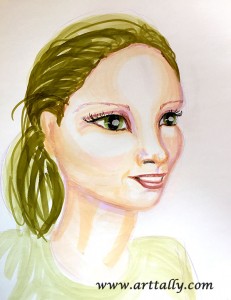 Drawing faces is becoming something of a passion of mine. That is not unusual. Portraits have been a popular subject choice for artists for as long as we have been drawing.
Drawing faces is becoming something of a passion of mine. That is not unusual. Portraits have been a popular subject choice for artists for as long as we have been drawing.
For many of us making art is a way of understanding ourselves and each other. Our faces are what we present to the world. Whether they reveal or conceal our innermost thoughts and feelings, faces can be endlessly fascinating.
Spending time learning to draw different facial expressions and even just different faces is time available to observe and contemplate. That feels like a privilege. I'm sure there is no substitute for a live model, but an ample supply of patient and willing models is not so easy to come by. Not everyone is comfortable with your intense and enduring scrutiny... funny that...
I have learned of a great resource to overcome this particular problem. Mark Simon has developed a series of books that contain photo references - especially made for all types of artists. There are books of adults from 20-83 years of age as well as a book of children from babies to young adults. The books show multiple expressions and angles of each face. Invaluable whether you are learning to draw faces as a beginner, or learning to draw facial expressions, or even if you are a professional needing to draw particular phonemes for animation or graphic novels.
I bought the book with children in it as they are my subject preference. The book is large and feels like a substantial support to my endeavours! At first I was a little disappointed because the cover is in colour and glossy but the interior pages are all in black and white. I soon realised, however, that this is in fact very useful. It is so much easier to see value contrast in a black and white photo. And since I seem determined to give all my subjects green, blue or pink hair, I am hard pressed to think why I would even want to see the photo in colour in the first place.
So, if you are looking for some inspiring faces to draw, check out these books. Yes, I know. There is Pinterest, of course. But for a variety of ages, and expressions over consistent faces, you can't beat a nice sturdy printed book. That's what I think.
A little help starting the creative process
 I have learned that you often need a little help starting the creative process. There can be a sort of inertia to overcome. Steven Pressfield calls it Resistance.
I have learned that you often need a little help starting the creative process. There can be a sort of inertia to overcome. Steven Pressfield calls it Resistance.
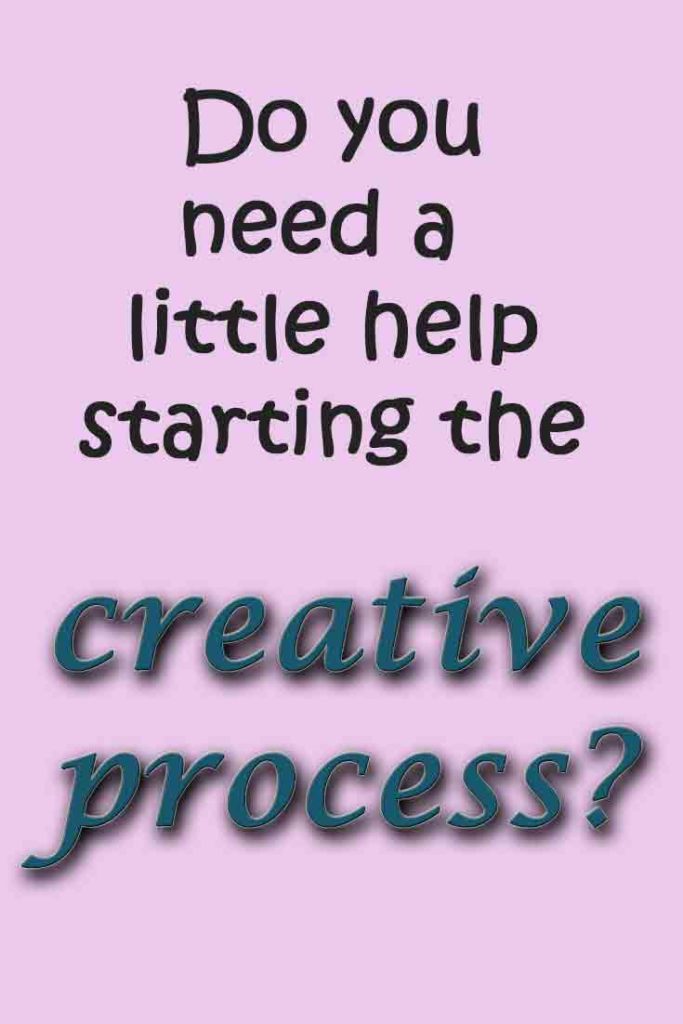 To me it is often just the seemingly insurmountable question of where to begin. Jane advises her students to copy with abandon in the interests of learning - not of course, to pass off these copies as one's own, but to start somewhere. To draw something.
To me it is often just the seemingly insurmountable question of where to begin. Jane advises her students to copy with abandon in the interests of learning - not of course, to pass off these copies as one's own, but to start somewhere. To draw something.
If I am drawing faces, then I can't help but start with Jane Davenport. I am loving her book... this one...
One of the things that troubles me is having all my faces turn out the same. Often quite pretty, but with something of a vacant stare. And once you get used to drawing a particular angle or pose it is very easy to get stuck in a rut.
So today I started out with a face and a bit of a body from the early part of Jane's book. It's quite a surprise how far away you can get from your original inspiration source. This particular page gave me a nice face shape to start with. Braids - I liked those. And a lovely languid pose. But by the time I was done choosing marker colours without thinking too much she turned out with a completely different feeling about her compared to the girl on Jane's page.
What a relief that a little bit of ourselves can't help but ooze out - even when we start from the very same point as somebody else.
Pale and interesting
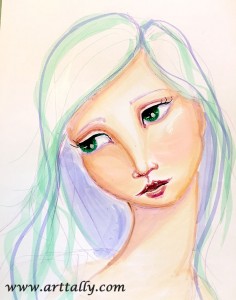 I am learning to love the beginning of a new series. The first one is hard. After a month of drawing a particular subject using a particular set of supplies you start feeling comfortable and easy. Changing supplies and subject feels like a challenge. Actually, that's rather the point.
I am learning to love the beginning of a new series. The first one is hard. After a month of drawing a particular subject using a particular set of supplies you start feeling comfortable and easy. Changing supplies and subject feels like a challenge. Actually, that's rather the point.
But I loved doing the first 'Jane-ish' face for August. And I loved the pale hair. So here is some more pale hair. In fact I think she is altogether 'pale and interesting'.
I like that phrase... pale and interesting. Reminds of a particular friend who went out and bought a very pale coloured lipstick when that was all the rage (oo way more years ago than either of us cares to recall). Anyway, she said this was her special lipstick for when she needed to be 'pale and interesting.' It was an important phase, I'm sure.
I didn't realise it was a Thing. But it seems it is. According to the Urban Dictionary, it refers to a rebellion against fake tanning, and what it might stand for. An embracing of one's natural appearance in the hopes that it will be taken as an indication of sufficient intelligence to resist the urge to paint oneself a shade of orange.
Here, here.
Learn to draw faces
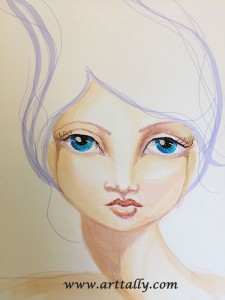 New month - new series! August is going to be all about faces. I have been enjoying drawing teapots but found myself wanting to put faces on them. So I have decided to spend August working on faces.
New month - new series! August is going to be all about faces. I have been enjoying drawing teapots but found myself wanting to put faces on them. So I have decided to spend August working on faces.
One of the first things I learned to draw was faces. Whimsical faces. 'Jane style'. And one of my favourite ways to draw faces is using alcohol markers - something else Jane introduced me too. There is nothing quite like them for making creamy skin tones.
Today I started with Jane's book on drawing beautiful faces. I started, of course, at the section that shows you how to draw a face step by step using markers. This is my version. I am using Spectrum Noir markers. They are the cheaper brand of alcohol markers, but as long as I use proper marker paper, I find that I rather love them. They don't have the brush tip unfortunately, just the chisel but I seem to be okay with that too. After all, significant precision is just not my style!
I highly recommend learning to draw faces. With a few good tips, it is really not as hard as you might think. I started off with Draw Happy, one of Jane's workshops which introduces face drawing. Then I was hooked and did more of her courses that cover faces.
Faces are fascinating. We communicate so much with our faces, even if we don't intend to. So being able to draw a face feels somehow empowering.
Studying faces and expressions to be able to draw them has made me a little more perceptive I think. It certainly makes me really notice someone who is talking to me. I'd like to say that it makes me more present. I think on a good day, it does. But it is also possible that I missed what they were saying because I was trying so hard to observe and remember the tiny expressive crease of brow, a particular dimple that appears only for a certain type of amusement, or the shapes made by shadows falling across the face.
It's all good. It's these tiny details of every little part of our lives that makes them worth living, I think.
Tea and lettering
If you love tea, and quotes and doodling it doesn't take long before you put them all together.
If you think you would like to have a go at doodling some letters - and why wouldn't you? Its easy, fun and doesn't require that you know how to draw!... Anyway, if you wanted to have a go, I recommend checking out one of my favourite online teachers Joanne Sharpe. She has several lettering classes available. Joanne has a delightful manner and her classes are accessible and broken down into short managable video lessons.
I have written about her before, so if you want to find out more about her classes you might want to read this next.
Explore more of the Tea Time post series here
See the kitchen inspired artwork available in the shop today
How to make a big goal manageable with tiny steps
A couple of months ago I resolved to create something every day and post it here. I have been pretty good at keeping this up but last week I seemed to be wavering.
I have also been doing the 100 day project with Elle Luna at The Great Discontent. I took up the additional challenge to post a daily 10 minute journal every single day for 100 days. Last week I completed that 100 days. Yay! (You can check it out on Instagram by the way).
Completing a challenge like this is rather motivating. It helped me remember how important it is to take tiny steps towards your goal. As the Chinese proverb says,
"The man who removes a mountain begins by carrying away small stones."
This is really the only way to take a great big goal, and turn it into something manageable. Never underestimate the cumulative power of small repeated actions. The big picture goal can be overwhelming. Choices too, can be overwhelming. So devising a plan of tiny steps is a way of taking a large abstract goal or objective and making it into a series of executable actions without the distraction of having to decide what to do next. For me, the overarching objective of learning to draw and paint better is now simply a question of turning up every day and making a painting of a predetermined subject. Much more achievable.
My main objective is to be creative every day, and to learn to draw and paint. Sometimes the writing part of my posts is a bit of a distraction. The main purpose is to keep drawing. And I am rather pleased with my subject choice for this month. It turns out that drawing curvy exotic teapots and then decorating them is a surprisingly relaxing pastime... who knew!
"Success is the sum of small efforts, repeated day in and day out." - Robert Collier
Explore more of the Tea Time series posts here
Count on a giraffe to brighten your day
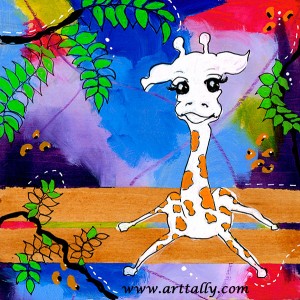 I am painting giraffes this week, and a jolly cheery thing it is to do.
I am painting giraffes this week, and a jolly cheery thing it is to do.
I started out with bright colourful backgrounds I loved .... (and a cup of tea)
And then did some sketches of various giraffes...
and then found that I was quite paralysed when it came to putting the giraffes on the backgrounds. It is hard when you have something you like in the background because you can't help but worry about messing it up. And in a sketch, all is forgiven. Lines that are not quite right seem okay in the sketch, but when you start painting the sketch they start to scream at you.
However, I bravely committed. And I am now resolving to paint more giraffes because they are such a remarkable animal. A most unusual beast. I have learned all sorts of things about them (no fear.... there is more on that in another post...) but today there is something else I want to share.
There is a most wonderful story about a giraffe. It is a children's story... my very favourite kind of story. Like all the best children's stories it has a message for us all. It is a tale about celebrating your uniqueness, forging your own path, knowing you can do anything you put your mind to by finding your own special way.
The book is called Giraffes Can't Dance by Giles Andreae. There are also narrated videos of the picture book available on You Tube. Happily I watched quite a few of them today.... all in the name of research. I think this one is my favourite. Check it out - it's very short, and sure to brighten your day (whatever age you may be).... here is the link.
The importance of true grit
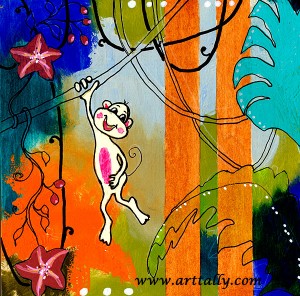 If I am honest, I have reached a bit of a lull in my quest to willingly post my daily creations. But I think this is an inevitable part of a creative process. The initial enthusiasm that comes with a new idea gets you going. Then that steam runs out and it becomes a question of persistence. To keep on placing one foot in front of the other. Now is the time to understand the importance of true grit.
If I am honest, I have reached a bit of a lull in my quest to willingly post my daily creations. But I think this is an inevitable part of a creative process. The initial enthusiasm that comes with a new idea gets you going. Then that steam runs out and it becomes a question of persistence. To keep on placing one foot in front of the other. Now is the time to understand the importance of true grit.
Jerry Seinfeld talks about marking a cross on the calendar every day that he does some writing. The point is to make a chain of crosses. Not to write something brilliant. But simply to show up and write. Every day.
So I feel that that is where I am right now. Making the most of the opportunity to demonstrate that I have some grit. I really don't like that word, somehow. But persistence (grit) has been shown to be a key predictor of success. (There is a TED talk by Angela Lee Duckworth that explains the importance of grit, if you happen to be in the mood for a vid!)
To be persistent you have to be okay with imperfection, with failure even. Persistence is continuing in spite of setbacks. A setback can just be a call to your creativity, awakening your problem solving equipment in order to find a way to move forward.
“The most important thing about art is to work. Nothing else matters except sitting down every day and trying.” ― Steven Pressfield
Persistence is probably what the 'p' stands for in professional. An amateur stops when things become hard, or when enthusiasm and inspiration wane. A professional continues doggedly on, whether they feel like it or not. Writers know all about this. For example,
“I write only when inspiration strikes. Fortunately it strikes every morning at nine o'clock sharp.” ― W. Somerset Maugham
The effort of persisting is very worthwhile, though. It is helpful to keep a mental note of past successes achieved through perseverance. Recalling these successes is a great encouragement when your persistence is being tested again. So I have seen for myself that continual practice, in small but steady ways really does build your skills. I am choosing to see this as an opportunity to rack up another mental note of successful perseverance in the memory banks. We will mark the occasion with this whimsical monkey swinging through mixed media vines on a wooden panel.
By the way, there is a test you can do to determine how 'gritty' you actually are. So if you love a personality test or two (let's be honest... who doesn't?) you can try this one...
Whimsy is fun
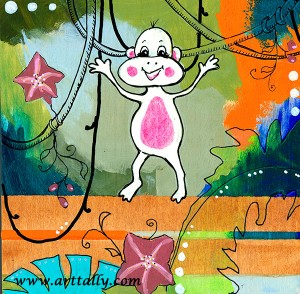 The next set of animal panels for this month feature this crazy little monkey.
The next set of animal panels for this month feature this crazy little monkey.
Apparently I can't stay away from whimsy. Whimsy is fun, and the reason I started painting in the first place was to have fun. Life is serious enough. So for me, painting is about a return to the simplicity of childhood. If it is cute and silly and colourful, I love it.
What better way is there to add a bit of fun to every day?
"Today was good. Today was fun. Tomorrow is another one." Dr. Seuss
Painting on wood
I have been loving painting on wood. It felt like a very modern thing to do. How wrong I was about that!
A very brief history lesson
Apparently, wood was the substrate used by most artists until the 16th century. It was a very prestigious medium in Greece and Rome. The oldest surviving Greek paintings are a series of 6th century BC painted tablets from Pitsa.
The old masters painted on many different types of wood, depending on what was locally available. For example, Albrecht Dürer (1471–1528) painted on poplar when he was in Venice and on oak when in the Netherlands and southern Germany. Leonardo da Vinci (1452–1519) used oak for his paintings in France. Hans Holbein (1497/8–1543) used oak while working in southern Germany and England.
The move towards canvas
In the 16th century, canvas began to gain popularity in Venice. Italians were making the best quality canvas at that point, for sails. Mantegna led the change from wood to the cheaper and more portable option of canvas.
Canvas has been the substrate of choice for all serious works of art since then. However, wooden panels have seen something of a renaissance recently and are being recognised as one of the most durable and archival supports available to painters today.
The advantages of painting on wood
I love wood because of its smooth surface. It feels more like working on paper than canvas does. The smoothness and firmness means that it is easier to use many different media on wood compared to canvas. For me, this increases the level of detail I might be able to achieve. I also appreciate the greater freedom this accords me when correcting for those little 'accidents' happy or otherwise.
You can even use watercolour on wood.
Sourcing wood for painting
I do understand that since it is only wood, it is possible to paint on any piece of wood. That is just a little bit too much effort prior to getting into the fun of painting for my liking. If you are more patient and skilled at carpentry than I, you can find your own wood, or even hardwood and gesso it to create a lovely solid, smooth painting surface. Lori McNee demonstrates in this video, if you are interested.
But my preference is for ready-to-go cradled wood panels. I kept seeing artists using them in my online travels and they appear to be easily available in America and Europe. However, I live in Australia, and they have been hard to find out here. I have finally found some (obviously...) Cavalier Art ship Australia wide, as far as I understand, so if you are a fellow Aussie that might help you out.
I rather like that what was old is now new again. I am happily embracing wood panels and looking forward to experimenting a bit more with them. Hopefully, you will too!
Amazing facts about the owl
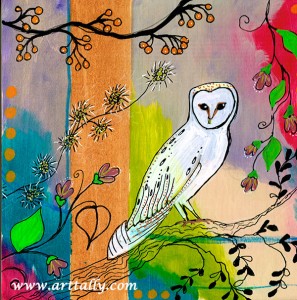 Whenever I choose something to draw, one of the things I love most is how studying its form in order to capture a likeness makes your curiosity about the subject grow. It is one of the things I love most about art. It can take you away from your everyday worries for a little to ponder something completely different. To contemplate and appreciate the world around us.
Whenever I choose something to draw, one of the things I love most is how studying its form in order to capture a likeness makes your curiosity about the subject grow. It is one of the things I love most about art. It can take you away from your everyday worries for a little to ponder something completely different. To contemplate and appreciate the world around us.
I chose owls for this first set in the June series because I think there is something a little bit special about them. Quiet, graceful, knowing. They are really not like any other bird.
We probably think of them as birds of prey, grouping them in our minds with hawks and eagles. But there is a school of thought in the taxonomy of these birds that their closest relatives are in fact hummingbirds and kingfishers. Hawks and eagles are diurnal hunters and therefore considered a little more primitive, akin to the cranes, herons, and other prehistoric-looking birds. Owls are nocturnal hunters, cleverly avoiding competition by hunting in opposite hours to the birds of prey.
One of the owl's most distinguishing features is its eyes. Those large round eyes are in fact completely immobile. They are not 'balls' as such but are shaped more like tubes. Unlike other birds, owl eyes are on the front of the head rather than the side, giving them the more human quality of binocular vision.
Of course, having totally immobile eyes, no matter how captivating they may be, is something of a limitation. The owl compensates by being able to rotate its head 270 degrees - not full circle as we may have liked to believe.
Being able to rotate your head in an almost complete circle does mean that you will be asking rather a lot of your neck. The owl neck has fourteen vertebrae, twice the number found in other birds. These vertebrae facilitate the impressive range of motion. Such a range of motion however, creates its own set of problems.
Twisting at the neck so dramatically impacts the blood circulation to the brain. The owl has some rather amazing systems to deal with this issue. For example it has developed alternative blood vessel routing and air-cushioned vessel casings to prevent rupture and stroke during violent head motion. And when neck movement cuts off circulation, the owl has special blood-pooling systems that collect blood to power their brains and eyes.
What a remarkable creature the owl is.
If you would like to know more about the amazing owl here are some good places to start:
- 10 Awesome facts about owls
- Video: True facts about the owl
- Comprehensive information on owls from Bioexpedition.com
Creative courage
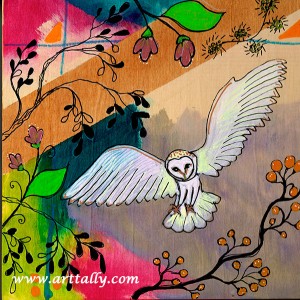 One of the things that I never really understood before was just how much courage creativity takes.
One of the things that I never really understood before was just how much courage creativity takes.
I have to admit that I spent an extraordinarily long time 'arranging my workspace' when I started this painting. I kept telling myself - its just paint and wood.... nothing to fear, surely?
And once you manage to get over that initial resistance its so much fun. I love colour. Splashing it about for the background just makes me happy. And I love my acrylic markers. I had some loud music going at first (I usually do... Only when that album was finished and I had silence did I notice the delightful scratch of the marker tip on the wood panel. Inexplicably soothing.
Indulging your creative side is a fascinating journey of self discovery. I don't think there are any solutions to finding creative bravery really, other than to feel the fear and do it anyway. That is what bravery is anyway, isnt it? It is not the absence of fear but the taking of action in spite of the fear.
"It takes a lot of courage to show your dreams to someone else." - Erma Bombeck
"Creativity requires the courage to let go of certainties." - Erich Fromm
"Creativity comes from trust. Trust your instincts." - Rita Mae Brown

